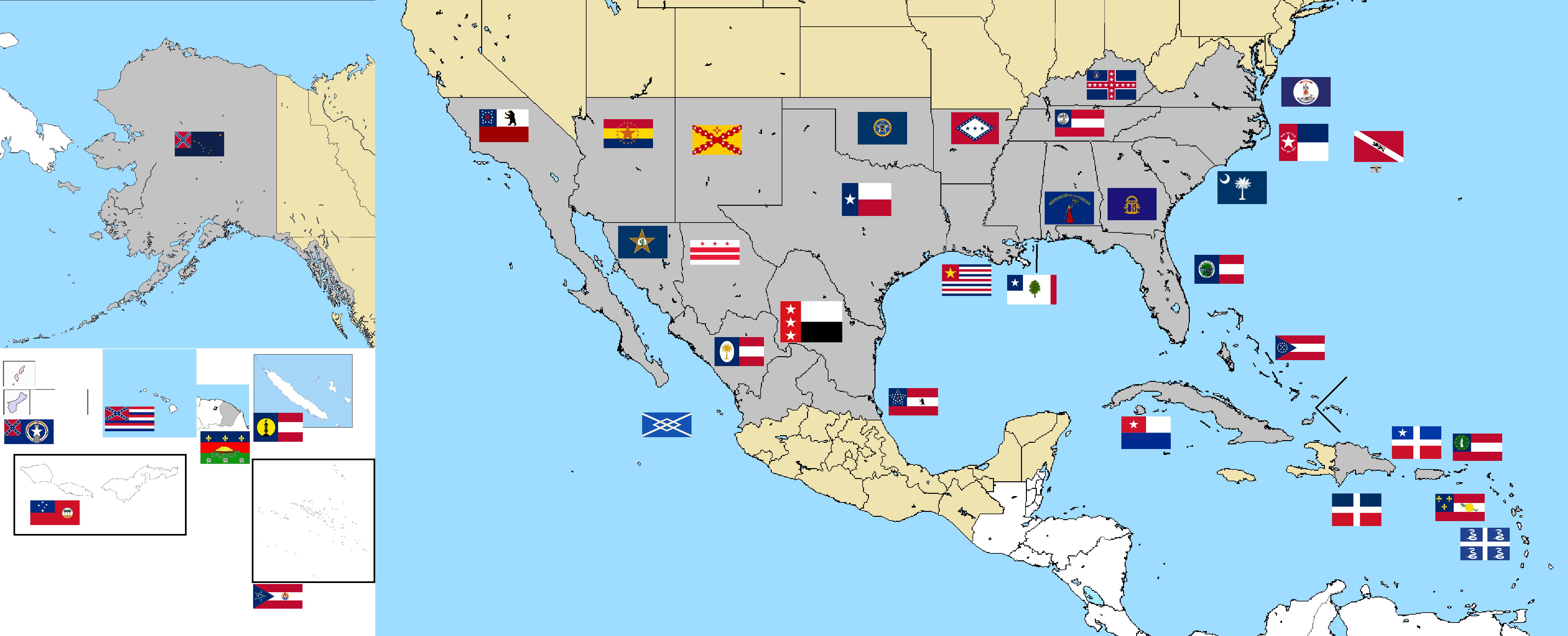HOME | DD
 JJohnson1701 — Deo Vindice Flag Map
JJohnson1701 — Deo Vindice Flag Map

Published: 2020-08-03 18:43:19 +0000 UTC; Views: 4673; Favourites: 43; Downloads: 8
Redirect to original
Description
Map of the Confederate States of America in 2020 with State flags.States
Alabama (1861)
Arkansas (1861)
Florida (1861)
Georgia (1861)
Kentucky (1861) - During the War for Southern Independence, Kentucky had both a Union and Confederate government vying for control. After Sherman was forced north into Kentucky, he was defeated by Johnston, Cleburne, Forrest, and the influx of black Confederate troops that buoyed the Confederate war effort since 1864. Missouri, west of the state, also had a Union and Confederate government, but within the negotiations, the Confederates got Kentucky in exchange for the Union getting Missouri for its location for railroads.
Louisiana (1861)
Mississippi (1861)
North Carolina (1861)
South Carolina (1861)
Tennessee (1861)
Texas (1861)
Virginia (1861)
Oklahoma (1862) - General Stand Watie and other Indians fought for the Confederate States, and were granted statehood within the Confederacy, making it the first Indian-majority state in North America. For thirty years, they required 1/16 or more Indian blood to allow people to settle in the state, but by 1892, this was obviously causing Oklahoma to fall behind other states in settlement and its economy. They changed the requirement to 1/64th Indian blood, or marriage to someone with 1/64 Indian blood. This opened up settlement to a larger pool, and brought in more farmers, mechanics, scientists, and others with valuable skills for the state to grow. Notable counties: Davis (OTL Cleveland) County, the home of the University of Oklahoma; Lee County (OTL Lincoln), with the county seat at Cleburne, OK (OTL Chandler).
California (1865) - In the treaty with the US, the Confederates were given southern California below the 37th parallel in exchange for the 'Nevada Notch' from Arizona. While not having as much gold as northern California in the US, the CS gained ports on the Pacific. Notable cities: Los Angeles (pop: 131,000), San Diego (capital, pop: 4.9 million), Saint Luke Cape, Saint Joseph of the Cape (OTL: Cabo San Lucas, San José del Cabo), popular resort towns with total population of 320,000; Dixie City (OTL Calexico-Mexicali, pop: 1.2 million), built in 1899 by Confederate Land Company to attract people to Dixie County, California.
Cuba (1874) - Confederate Generals and soldiers were fighting on the side of Cuban rebels, angering Spain for interference in its empire, and with the firing on a Confederate ship in Havana harbor in 1873, the Confederates went to war with Spain, resolving it 11 months later. Cubans and Confederates saw the need for Cuba to remain in the Confederacy, and was granted statehood in 1874.
Hawaii (1874) - The same year the Confederates were distracted by their war with Spain, the US and UK attempted a coup in Hawaii, which had US, CS, and UK citizens all through the islands. The coup failed, but the Hawaiian royal family petitioned the CS for admission as a state, knowing it would end the kingdom.
New Mexico (1876) - The first territory to become a state (California had been a state, then a Confederate territory, then a state again), to try to help Texas with Indian raids, both NM and TX gave Indians two choices - go to Oklahoma or stay on reservations. Most chose Oklahoma, making it a certain Indian majority state. New Mexico grew with mineral wealth. Notable cities: El Paso (pop: 1.3 million), a cross river city with El Paso, TX; Albuquerque, called White Oak from 1946-1996 as a result of the Mexican invasion of 1941-1943 during WW2.
Rio Grande (1885) - Growing south of Texas, three territories purchased from Mexico in 1867 finally gained statehood in 1885, populated with Texans, Georgians, Louisianan, and Arkansans. Notable Cities: Monterey (OTL Monterrey), Victoria (OTL Ciudad Victoria), Tampico (port city)
Arizona (1892) - With the addition of territory from Mexico to the 31st parallel, Arizona gained a seaport for its goods, and became a state soon after NM.
Jefferson (Zacatecas) (1893) -With new farmlands and the McCormick reapers and new rail lines, the southwestern state was named for Thomas Jefferson, the author of the Declaration of Independence. Notable Cities: Tucson, Phoenix, Rocky Point (OTL: Puerto Peñasco, pop: 296,780), Nogales
Washington (chihuahua) (1894) - just south of New Mexico, this was named for the general who won the American Revolution, and who appears on the CS Great Seal. Notable cities: Mount Vernon (OTL: Chihuahua, capital)
Puerto Rico (1895) - Having won independence from Spain, PR remained a territory for about 20 years, before enough Confederates had settled to make Davis (the capital) comfortable with granting statehood, believing it to have assimilated successfully into the Confederacy. Notable Cities: San Juan (capital)
Sonora (1895) - Just south of Arizona, this state became a haven for Confederate Amish and farmers, and the 'Apostolic Christian Church' - a southern-influenced originalist Christian church that is a mix between Mormon and Amish in a way.
Santo Domingo (Dominican Republic) (1895) - Bought in 1870 for $1.5 million, this island gained a naval port and became an important island for coffee, sugar, and cocoa production.
Durango (1896) - merged with Sinaloa in 1867 after purchase by the CS, this state grew slowly until automobiles brought tractors to the region, enabling the farming of the region to grow rapidly. It is nicknamed the Confederate Breadbasket for the vast produce it makes east and west of its mountains (tomatoes, cotton, beans, corn, wheat, sorghum, potatoes, soybeans, mangos, sugarcane, peanuts, squash, chilli peppers, apples, alfalfa, apples, pears, membrillo, apricots, peaches, bananas, cherimoyas, guavas, zapotes, plums, avocados, oranges, and other types of citrus; sheep, goat, cattle, pigs, bison). Notable cities: Breckinridge (capital)
Veracruz (SLP) (1905) - An important port at Tampico makes this state important for bringing goods into the southwest. Like Durango, silver and gold were found here, bringing a lot of Confederate settlers to the region. Oil was discovered soon after Spindletop, leading to a huge growth in the state. Notable Cities: Saint Louis (OTL San Luis)
Alaska (1954) - Bought in 1867 from Russia, this gained statehood after its population grew enough from the gold rushes and discovery of oil.
Bahamas (1954) - Bought in 1917 from the UK, this became a vacation haven after WW2 with vacationing veterans and finally gained statehood in 1954
Guadeloupe (1958) - Captured and ceded from France, this island took 40 years to gain statehood, with Davis wanting to ensure it was assimilated enough
Martinique (1958) - Captured and ceded from France, this island took 40 years to gain statehood, with Davis wanting to ensure it was assimilated enough
New Caledonia (1959) - Captured and ceded from France, this island took 40 years to gain statehood, with Davis wanting to ensure it was assimilated enough
Mariana Islands (1961) - Won from Spain, these islands were taken over by Japan during WW2, and were important as a naval base afterwards
Polynesia (1972) - Captured and ceded from France, these islands took 40 years to gain statehood, with Davis wanting to ensure it was assimilated enough
Guyana (1974) - Captured and ceded from France, this territory took almost 60 years to gain statehood, with Davis wanting to ensure it was assimilated enough. Today its population is roughly 30% mixed, 60% European, and 10% other (native Indians, Asian, etc). The economy is based on the space industry, export of bananas, gold, sugar, fish, and tourism.
Virgin Islands (1976) - Purchasing the Danish and British Virgin Islands, the combined island chain became the bicentennial state
Samoa (1976) - Bought from Germany in 1917, and the US shortly after, the combined islands became a state in 1976. Population: 286,000, 82% Samoan, 14% European, 3% black. Capital: Apia. Legislature is bicameral, with a Senate of 40, and a House of 140. Exports: cocoa, coconut products, bananas, rubber. The economy is dependent upon tourism. Of those 82% Samoan, over 48% are mixed Samoan-European over the last 90 years, as the island's standards of beauty gravitated towards those of the Confederate States as a whole, and Confederates married Samoans, whose children also married Confederates or other mixed children.

























